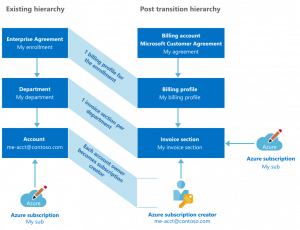
The Microsoft Customer Agreement is Replacing Your EA: What You Need to Know and Why You Need a CSP Partner
As you may have heard, Microsoft is shifting to a new transaction platform for purchasing Azure. The goal of this evolution is to streamline the Azure experience as a customer while better supporting the needs of organizations through greater transparency and quicker access to the latest Azure features.
But with the new transaction platform comes a new agreement framework, dubbed the Microsoft Customer Agreement (MCA). The MCA falls under the CSP agreement, and will be replacing all Enterprise Agreements as of the end of January.
What does the MCA mean for my organization?
Under the new MCA, organizations will have three ways to access Azure resources:
- Self-Service: Companies can simply head to Microsoft’s “modern commerce platform” and purchase Azure consumption or a Microsoft license, no support required. This is great news for companies who have a large in-house IT team willing to dedicate themselves full-time to their cloud infrastructure. It’s also good for those with minimal or simple Azure requirements who just want to get up and running as quick as possible.
- Partner-Led: This strategy involves working closely with a partner – such as a managed service provider like Hanu – who will provide end-to-end solution support. In this scenario, organizations will access Microsoft services and licenses through a Microsoft partner who assists with support and billing, licensing, in addition to value-added services that can range from migration services to security and regulatory compliance oversight.
- Field-Led: Finally, there’s the option of dealing directly with Microsoft. This option most closely resembles the current Enterprise Agreements, with organizations interacting with the Microsoft Account Team, as well as with the Microsoft Partner Ecosystem when the need arises.
What’s most important to know about these three pathways is that they’re linked. Under the new MCA, organizations will be able to switch between them based on what works best for them in a given situation, and not product use rights or pricing.
For example, it’s possible for a company to go direct to Microsoft and purchase an Office 365 license without any involvement from Microsoft or a partner (self-service). The company could still have their billing relationship with the Microsoft Account Team (field-ld), while retaining partner services as required (partner-led).
This kind of flexibility is what the MCA is intended to achieve, all through a single, streamlined agreement. The MCA never expires, and terms are updated dynamically as needed, allowing organizations to purchase across channels without the need for additional agreements.

CSP: The Best Part of the New MCA Agreement
Perhaps the biggest advantage organizations stand to gain from the MCA is that it brings Microsoft’s Cloud Service Provider (CSP) agreement onto the modern commerce platform. Given that the modern commerce platform is linked to the MCA, the prospect of converting to CSP when an EA expires is now a compelling option for many companies.
For most businesses, choosing the CSP and partner-led MCA path is the best option. There are several reasons for this:
- Value Added Services: A certified Microsoft Azure Managed Service Provider (MSP) such as Hanu can provide an array of services in addition to what Microsoft offers – and beyond what most in-house teams can handle on their own. This includes data and application modernization and innovation, infrastructure assessment, security, DevOps, governance and migration services, as well as 24/7 proactive managed Azure services. All of this can be included on the same Azure bill for a unified billing experience.
- Superior Technical and Billing Support: When you partner with a CSP provider, you have an immediate point of contact should you have any issue. If anything goes wrong, a (good) CSP partner will have a team available 24/7 to lend support.
- Better Licensing Support: Managing licenses, tracking installations, staying current on licensing rules and compliance, and ensuring regular renewals are a massive headache. An experienced CSP partner will have a wealth of expertise to draw on, enabling you to maximize your licensing investments. You’ll get the same Azure services you would normally use, without the drain on your IT resources.
- Monthly Billing: In addition to licensing support, when you bill through a CSP partner you pay only once per month, rather than annually. This lets you reduce costs when necessary, adopt new technology or scale up quickly, and only pay for what you use. And unlike previous EAs, there are no upfront licensing fees when you purchase Azure through a CSP.
Microsoft channel chief Gavriella Schuster elaborates on the benefits of CSP an interview with CRN “If a customer signed up originally on a modern commerce agreement, and then they learn that there’s a partner that’s actually delivering a whole bunch of services they would rather have as part of this contract, they can easily move that subscription into CSP… whereas today, because those are on completely different platforms, that was a very difficult thing to do.”
“We are hoping this makes it easier to do business with Microsoft, both for our partners and our customers,” Schuster said. “And we may find that because those partners’ services are so compelling, that more customers choose to go with the partners’ services and have the partner just administer the whole subscription. And so we may find more going to CSP.”
Have questions about the new MCA and how it will impact your organization? Contact the Azure Cloud experts at Hanu today. We’re happy to answer any questions you might have. We will also provide a FREE Cost Optimization Assessment and a Security Scorecard of your current Azure environment.



